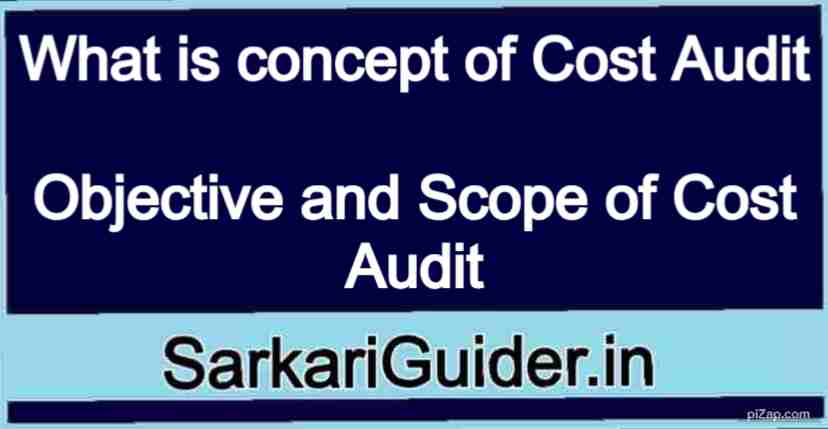
What is concept of Cost Audit
What is Concept of Cost Audit – The term with reference to financial accounting means the examination of books of accounts in order to ensure that financial statements are prepared as per statutory requirement and they reveal a true and fair view of the business undertaking. The phrase Concept of cost audit is defined by ICMA. London as “the verification of cost accounts and a check on the” adherence to cost accounting plan.”
According to this definition, cost audit involves two functions.
(1) to verify that cost accounting records such as statement of costs, reports, etc. have been maintained according to cost accounting system and
(2) to verify whether cost principle, plans, procedures and objectives have been adhered to by the organization. We can add a third function to the cost audit aspect, viz, to detect errors and to prevent frauds and misappropriations while preparing accounts.
The origin of the concept of cost audit could be traced to the Second World War period when the practice of cost plus contract began. In India, cost audit is statutorily prescribed as it assists management in decision-making process by providing adequate cost data.
Cost audit helps management in many respects such as in price fixing, avoiding wastages, reorganization of purchases and sales, in exercising internal control etc.
What is Objective of Cost Audit
What is Objective of Cost Audit– Cost audit has the following broad objects:
1. To see that proper and adequate cost accounting books and records are maintained.
2. To see whether cost accounting principle have been properly applied.
3. To compact actual cost incurred with those attainable under Cost Accounting efficiency audit.
4. To examine the efficiency or otherwise of it, better, utilization of resources and whether maximum capacity has been achieved.
5. To determine the method of allocation and apportionment of overheads and to examine the system of valuation of stock.
6. To facilitate inter-firm and intra-firm comparison of cost and business performance.
7. To facilitate price fixation by furnishing cost data.
8. Casting a moral check on the cost accounting staff and achieving improvement of the cost accounting system.
9. Checking the correctness of cost accounting records.
10. Verifying the adherence of cost accounts to the established systems and procedures.
11. Ascertaining how far the cost: accounting system is adequate for cost control and managerial decision-making.
12. Ascertaining whether cost reporting procedure is inadequate or wasteful.
13. Checking the reconciliation of costing profit or loss with the financial profit or loss.
14. Bringing out inefficiencies in the matter of utilization and procurement of materials, utilization of and payment to labor and incurrence of overheads and direct expenses.
Scope of Cost Audit
Scope of Cost Audit – Cost audit covers two important aspects. They are-
(1) Property Audit
(2) Efficiency Audit
(1) Property Audit – Kohler in his books on Dictionary of Accounts has defined the term property is “that which meets the tests of public interest, commonly accepted customs and standards of conduct.” Propriety audit is concerned with audit of various activities and plans of management which have a close bearing on the revenues and expenditure of the business.
The cost auditor must ensure that each item of expense is properly sanctioned by the management and incurrence of such item of expense is justifiable under this audit A cost auditor has to ascertain.
(a) whether the planned expenses results in optimum benefit or not.
(b) whether the amount and ways of its incurrence are designed to give best result.
(c) whether return on capital can be improved by some other alternative.
(2) Efficiency Audit or Performance Audit or Profitability Audit – It relates to appraisal of the performance of a plan to know whether it has been efficiently executed. In other words, it ensures that the results obtained are according to the plans.
It is concerned with examining the plans, comparison of the actual performance with budgeted performance and finding out the reasons for the variances so as to take remedial actions.
Its main object is to maintain economy by ensuring that whatever investments or expenses are incurred they result in maximum benefit. It also ensure a balanced investment or various project so as to get optimum returns on capital employed.
इसे भी पढ़े…
- Definition of Primary Distribution of Overheads
- What is Re-Apportionment of Service Departments Overheads
- Process of Classification of Overheads | Basis of Overhead Classification
- What is Overheads | Bases For Allocation of Expenses to Departments
- What is Meaning of Incentive Wage Method | Methods of Wage Payment
- Meaning of Collection Allocation | Apportionment of Overhead Expenses
- What is Primary Distribution of Overheads
- What is Meaning of Overhead | Classification of Overhead
- Process of Classification of Overheads | Basis of Overhead Classification
- Advantages of Fixed and Variable Overheads | Difference Between Fixed & Variable Overheads
- What is Absorption of Selling and Distribution Overheads
- What is Money, Definition, Functions and various kinds of Money
- What is Apportionment of Overheads, Principles, Difference






